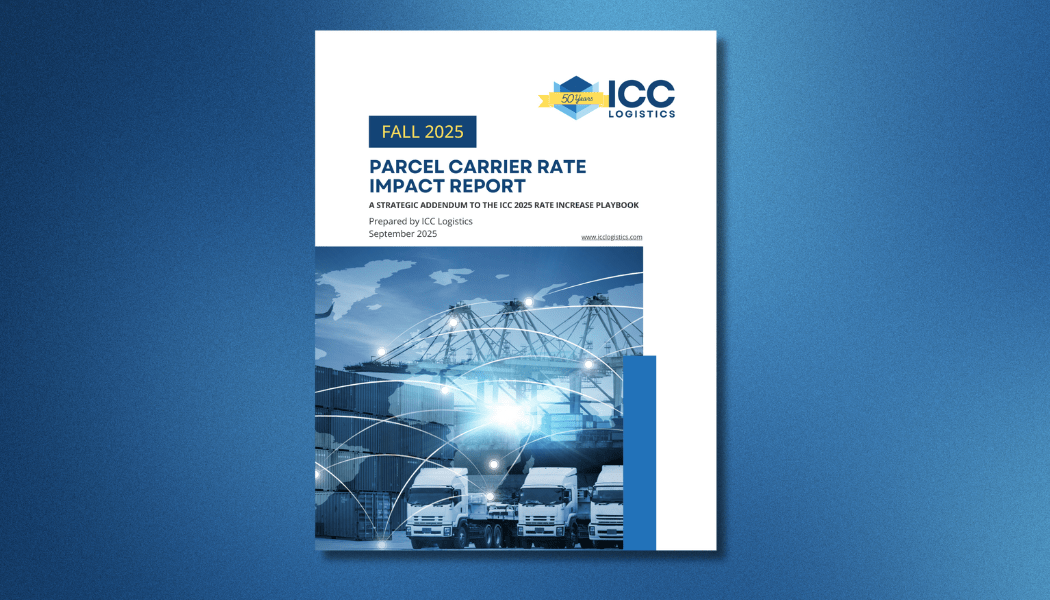One Inch Could Cost You Thousands
Dimensional weight pricing is shifting again, and if your team isn’t paying close attention, you may be facing unexpected cost increases in just a few weeks. Effective August 18, 2025, FedEx will implement a key change in how it rounds package dimensions for billing purposes, a seemingly small adjustment that can lead to substantial cost increases across high-volume parcel operations.
For shippers managing e-commerce fulfillment, subscription boxes, lightweight goods, or irregularly shaped items, the impact will be especially pronounced. Previously, FedEx rounded down when calculating dimensional weight. After August 18, they’ll begin rounding each dimension up, increasing the billable weight of many packages, even if your actual products or processes haven’t changed.
The result: Higher shipping charges on the same freight.
This mid-year change follows a growing trend in the parcel industry: frequent, incremental cost increases introduced quietly and with limited visibility. And if you’re not actively tracking them, these changes could steadily chip away at your margins without warning.
What’s Changing in FedEx’s Dimensional Weight Policy?
Starting August 18, 2025, FedEx will begin rounding each package dimension up to the nearest whole inch when calculating dimensional (DIM) weight, a change from the current method, which rounds dimensions down. While this may sound like a minor shift, the financial consequences for shippers are far from negligible.
To illustrate the difference, here’s a real-world example:
Package with dimensions of 12.2” x 10.3” x 6.4”
Before the change:
- Dimensions Rounded down to 12” x 10” x 6” = Dimensional Weight of 6 Lbs.
- Published Cost of a Zone 4, 6 Lbs. Ground Package = $16.33
- Published Cost for a Zone 4, 6 Lbs. Priority Overnight Package = $124.88
After the change:
- Dimensions rounded up to 13” x 11” x 7” = Dimensional Weight of 8 Lbs.
- Published Cost of a Zone 4, 8 Lbs. Ground Package = $17.34 (Increase cost of 6.2%)
- Published Cost for a Zone 4, 8 Lbs. Priority Overnight Package = $136.13 (Increase in cost of 9%)
Now imagine this increase applied across hundreds or thousands of weekly shipments. For high-volume shippers, this change could add thousands to monthly spend, especially if your operation ships lightweight, bulky items that are particularly vulnerable to dimensional weight pricing.
This policy update comes with little fanfare, yet it fundamentally alters the calculation of package costs. Many logistics and finance teams may not realize the change has occurred until they see a jump in costs — and by then, it may be too late to respond effectively.
Why Are Carriers Making Mid-Year Changes Like This?
In the past, shippers could count on a relatively predictable rhythm: one General Rate Increase (GRI) per year, typically announced in Q4 and implemented at the start of the new year. But that model is rapidly fading. Over the last few years, FedEx and UPS have increasingly adopted a more fragmented, less transparent approach to rate and rule changes — spreading increases throughout the year in smaller, targeted adjustments.
These mid-year changes now come in many forms:
- Higher Additional Handling Charges – often triggered by size, weight, or packaging type
- New or adjusted Delivery Area Surcharges (DAS) – quietly expanding the number of zip codes that incur extra fees
- Zone realignments – subtle shifts that increase cost-to-serve in regions once considered economical
- Rising and volatile Fuel Surcharges – fluctuating frequently and with minimal notice
- Dimensional billing rule changes – like the one effective August 18
What makes these changes especially problematic is how they’re communicated, or rather, how poorly they are communicated. Many of these adjustments appear with little to no direct announcement. Sometimes, they’re buried in carrier updates or filed quietly in rate guides. Other times, they’re not formally published at all, leaving shippers to absorb the increases blindly.
This lack of transparency puts logistics teams at a significant disadvantage. Without clear notice or detailed cost modeling, it becomes nearly impossible to forecast shipping spend accurately — and even harder to explain cost overruns to finance and operations leadership.
Want to see another example of how subtle rule changes can inflate costs? Read:
Hidden Zip Code Changes Could Be Costing You Big »
How Do Dimensional Weight Rules Affect Profit Margins?
Dimensional weight pricing (DIM weight) was designed to align shipping charges with the space a package occupies in a delivery vehicle — not just its actual weight. While logical from a carrier efficiency standpoint, it often results in unexpected cost increases for shippers, especially those who deal with lightweight but bulky items.
Industries most affected include:
- E-commerce and retail: Apparel, home goods, health, and beauty products
- Consumer electronics: Small devices with protective packaging
- Subscription box services: Items shipped in fixed-size branded boxes
- Medical and lab supply: Lightweight but oversized items requiring cushioning
Here’s where it gets costly: Even a single inch can push a shipment into the next billable weight bracket.
Consider how this plays out under the new FedEx policy:
Let’s say you’re shipping a package measuring 12.2” x 10.3” x 6.4” — dimensions that wouldn’t typically raise concern.
Before August 18, FedEx would round those figures down to 12” x 10” x 6”, resulting in a dimensional weight of 6 lbs.
After August 18, under the new rule, FedEx will round each dimension up, bringing the total to 13” x 11” x 7” — now billed as 8 lbs.
That seemingly minor change drives real cost impact:
- +6.2% increase in Ground shipping cost
- +9% increase in Priority Overnight shipping cost
Now imagine this happening hundreds or thousands of times per month. If you’re not actively modeling the impact of dimensional weight on your SKUs, or if you’re relying solely on carrier invoices without a parcel audit, you may not even realize these increases are happening. And by the time you do, the cumulative profit erosion may already be significant.
This is why understanding dimensional weight — and how it’s applied differently by each carrier and service level — is no longer optional. It’s a critical factor in cost control and margin preservation for modern shippers.
Why It’s Critical to Track More Than Just GRIs
If your logistics strategy is still focused solely on annual General Rate Increases (GRIs), you’re only seeing part of the picture. Today’s shipping environment is defined by frequent, low-visibility changes that can significantly inflate your parcel and freight costs — often without triggering any alarms in your procurement or finance systems.
While GRIs typically average 5–7% annually, the actual year-over-year increase in total shipping spend is often much higher due to cumulative effects from:
- Accessorial fee increases (Additional Handling, Residential Delivery, Oversize Fees)
- Fuel surcharge volatility, which can change weekly
- ZIP code and zone reclassifications that quietly shift cost structures
- Dimensional weight rule changes, like FedEx’s August 18 update
- Package weight rounding and minimum billable weight thresholds
These granular changes are often overlooked, yet they can have a bigger financial impact than the headline GRI. ICC Logistics has seen clients experience total shipping cost increases of 10% or more in a single quarter, even when volume stayed flat and GRIs were already factored in.
This is why proactive cost management now requires a data-driven, real-time approach. That includes:
- Freight and parcel invoice audits to catch overcharges and rule misapplications
- Contract performance monitoring to ensure your negotiated terms are honored
- Benchmarking tools to compare your rates against similar shipping profiles
- Scenario modeling to evaluate the financial impact of new rule changes before they hit your bottom line
Want a real example of how these hidden shifts can affect your spend?
Explore how June 2025 fuel surcharge updates are reshaping parcel shipping costs.
What Can You Do to Stay Ahead of Mid-Year Increases?
When shipping costs climb without warning, it’s rarely due to a single rate hike. Instead, it’s usually the result of multiple small changes adding up quietly over time — changes like the FedEx dimensional weight policy taking effect August 18.
To avoid being caught off guard, shippers need more than basic carrier communication or standard internal reporting. They need a proactive cost management strategy built around data, expertise, and continuous oversight.
At ICC Logistics, we help high-volume shippers mitigate cost spikes and navigate mid-year rate and rule changes before they take a toll on margins. Our approach includes:
- Freight and Parcel Audit Services
We conduct ongoing audits to identify billing discrepancies, misapplied accessorial charges, incorrect DIM weight calculations, and more — helping clients recover overpayments and prevent repeat errors.
One recent client recovered $75,000 in invoice errors in a single quarter. - Carrier Contract Negotiation
We benchmark your existing agreements against market standards and your specific shipping profile, then negotiate directly with carriers to improve terms, reduce risk, and align with your operational needs.
For some clients, renegotiated contracts have led to up to 30% in annualized savings. - Parcel Consulting and Impact Modeling
We simulate how dimensional weight rules, fuel surcharge updates, or zone changes will affect your cost structure, giving you the visibility you need to re-engineer packaging, adjust service selections, or renegotiate with leverage.
This isn’t about chasing refunds after the fact — it’s about engineering cost control into your shipping strategy. By staying ahead of changes like the August 18 FedEx DIM rule, you can avoid reactive decisions and protect your bottom line.
Don’t Wait for the Invoice Shock
In today’s shipping landscape, unexpected costs aren’t a matter of if, they’re a matter of when. Carrier updates like FedEx’s new dimensional weight rounding rule rarely make headlines, but they can quietly drive up your spend in ways that are difficult to catch without expert oversight.
Every unannounced change — whether it’s a new surcharge, a DIM weight recalculation, or a zone reclassification — represents a choice: absorb the cost, or challenge it with data and action.
At ICC Logistics, we believe shippers should never be in the dark when it comes to their freight and parcel spend. That’s why we offer a risk-free shipping assessment to help companies understand the real impact of mid-year carrier changes and identify opportunities to:
- Recover lost dollars through billing audits
- Restructure contracts for more favorable terms
- Reengineer shipping processes to avoid unnecessary charges
Your carrier isn’t going to flag these changes for you — but we will.
Let’s make sure the next invoice doesn’t bring surprises.
Contact ICC Logistics today for a no-risk assessment.
Recommended Next Reads:
- Hidden Zip Code Changes Could Be Costing You Big
- Updated FedEx and UPS Fuel Surcharge Rates for June 2025



 to receive our FREE white papers:
to receive our FREE white papers: